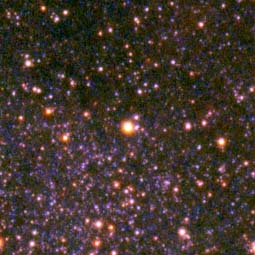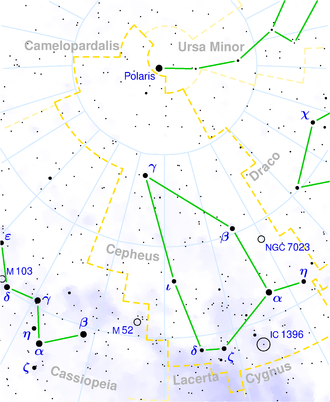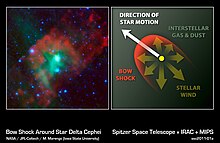Delta Cephei
|
Star Delta Cephei |
|||||||||||||||||||||
|---|---|---|---|---|---|---|---|---|---|---|---|---|---|---|---|---|---|---|---|---|---|

|
|||||||||||||||||||||
| AladinLite | |||||||||||||||||||||
|
Observation dates equinox : J2000.0 , epoch : J2000.0 |
|||||||||||||||||||||
| Constellation | Cepheus | ||||||||||||||||||||
| Right ascension | 22 h 29 m 10.27 s | ||||||||||||||||||||
| declination | + 58 ° 24 ′ 54.7 ″ | ||||||||||||||||||||
| Apparent brightness | 3.75 (3.49 to 4.36) mag | ||||||||||||||||||||
| Typing | |||||||||||||||||||||
| B − V color index | +0.60 | ||||||||||||||||||||
| U − B color index | +0.36 | ||||||||||||||||||||
| Spectral class | F5 Iab (F5Ib - G1Ib) | ||||||||||||||||||||
| Variable star type | DCEP | ||||||||||||||||||||
| Astrometry | |||||||||||||||||||||
| Radial velocity | −24 km / s | ||||||||||||||||||||
| parallax | Hip: 3.77 ± 0.16 mas HST: 3.66 ± 0.15 mas |
||||||||||||||||||||
| distance | 887 ± 26 ly 272 ± 8 pc |
||||||||||||||||||||
| Visual absolute brightness M vis | −3.47 ± 0.10 mag | ||||||||||||||||||||
| Proper movement | |||||||||||||||||||||
| Rec. Share: | 15.35 mas / a | ||||||||||||||||||||
| Dec. portion: | 3.52 mas / a | ||||||||||||||||||||
| Physical Properties | |||||||||||||||||||||
| Dimensions | 4.5 M ☉ | ||||||||||||||||||||
| radius | 44.5 R ☉ | ||||||||||||||||||||
| Luminosity |
2000 L ☉ |
||||||||||||||||||||
| Effective temperature | 5500-6800 K | ||||||||||||||||||||
| Metallicity [Fe / H] | +0.08 | ||||||||||||||||||||
| Rotation time | 40 d | ||||||||||||||||||||
| Age | 10 8 a | ||||||||||||||||||||
|
Other names and catalog entries |
|||||||||||||||||||||
|
|||||||||||||||||||||
Delta Cephei is a variable star in the constellation of Cepheus , the variability of which was discovered in 1784 by the English astronomer John Goodricke .
properties
Delta Cephei is a yellow supergiant , located at a distance of 272 parsecs (887 light years ) from the Sun is. Its apparent brightness fluctuates between 3.48 m and 4.37 m with a period of 5.36643 days , with its spectral type also changing between F5Ib and G2Ib. This is associated with a periodic change in the surface temperature of around 1000 ° C.
Delta Cephei is the prototype of a class of pulsation-variable stars , the so-called Delta Cephei stars , which - as their period duration only depends on the luminosity - plays a role in the measurement of the distance of galaxies .
Delta Cephei is also a double star that can be separated in prism binoculars . Its companion star is located at a position angle of 191 ° 41 " from Delta Cephei. It has an apparent magnitude of 6.3 m and belongs to spectral class B7.
Web links
- Delta Cephei . In: American Association of Variable Star Observers . September 2000. Archived from the original on June 8, 2008. Retrieved June 21, 2008.
- Delta Cephei . In: The Internet Encyclopedia of Science . Retrieved June 21, 2008.
- Delta Cephei, 27 Cephei . In: SEDS . Retrieved June 21, 2008.
- Jim Kaler: Delta Cephei . In: University of Illinois . STARS. Retrieved October 13, 2017.
Individual evidence
- ^ A b c F. van Leeuwen: Validation of the new Hipparcos reduction . In: Astronomy and Astrophysics . 474, No. 2), November 2007, pp. 653-664. arxiv : 0708.1752 . bibcode : 2007A & A ... 474..653V . doi : 10.1051 / 0004-6361: 20078357 .
- ↑ a b c del Cep. In: SIMBAD . Center de Données astronomiques de Strasbourg , accessed September 16, 2018 .
- ↑ a b del Cep. In: VSX. AAVSO, accessed September 16, 2018 .
- ^ G. Fritz Benedict, et al .: Astrometry with the Hubble Space Telescope: A Parallax of the Fundamental Distance Calibrator δ Cephei . In: Astronomical Journal . 2002. arxiv : astro-ph / 0206214 . bibcode : 2002AJ .... 124.1695B . doi : 10.1086 / 342014 .
- Jump up ↑ D. Majaess, D. Turner, W. Gieren: New Evidence Supporting Cluster Membership for the Keystone Calibrator Delta Cephei . In: Astrophysical Journal . 747, No. 2, 2012, p. 145. arxiv : 1201.0993 . bibcode : 2012ApJ ... 747..145M . doi : 10.1088 / 0004-637X / 747/2/145 .
- ↑ a b c L. D. Matthews, et al .: New Evidence for Mass Loss from δ Cephei from HI 21 cm Line Observations . In: The Astrophysical Journal . 744, No. 1, January 2012, p. 53. arxiv : 1112.0028 . bibcode : 2012ApJ ... 744 ... 53M . doi : 10.1088 / 0004-637X / 744/1/53 .
- ^ MAT Groenewegen: Baade-Wesselink distances and the effect of metallicity in classical cepheids . In: Astronomy and Astrophysics . 488, No. 1, September 2008, pp. 25-35. arxiv : 0807.1269 . bibcode : 2008A & A ... 488 ... 25G . doi : 10.1051 / 0004-6361: 200809859 .
- ^ Akira Uesugi, Ichiro Fukuda: Catalog of rotational velocities of the stars . In: Contributions from the Institute of Astrophysics and Kwasan Observatory (University of Kyoto) . 1970. bibcode : 1970crvs.book ..... U .


